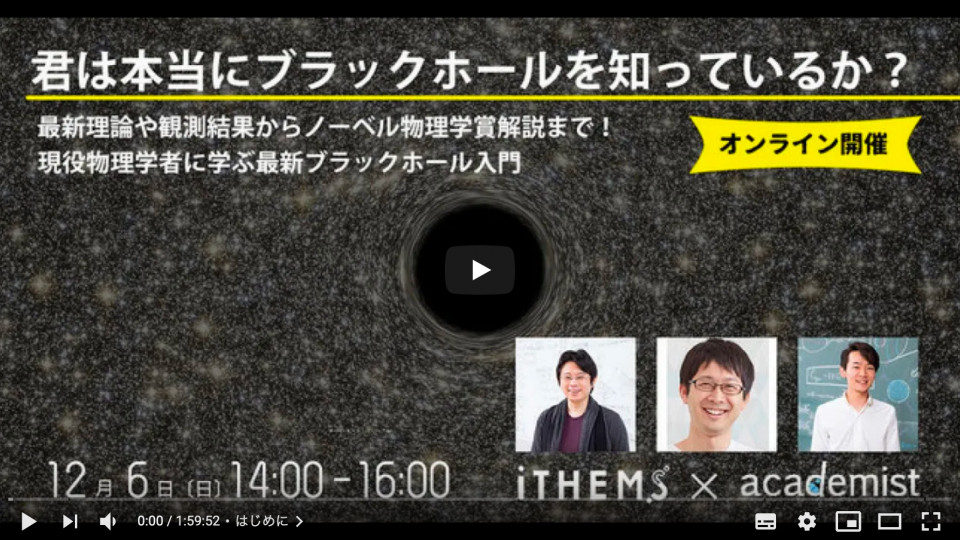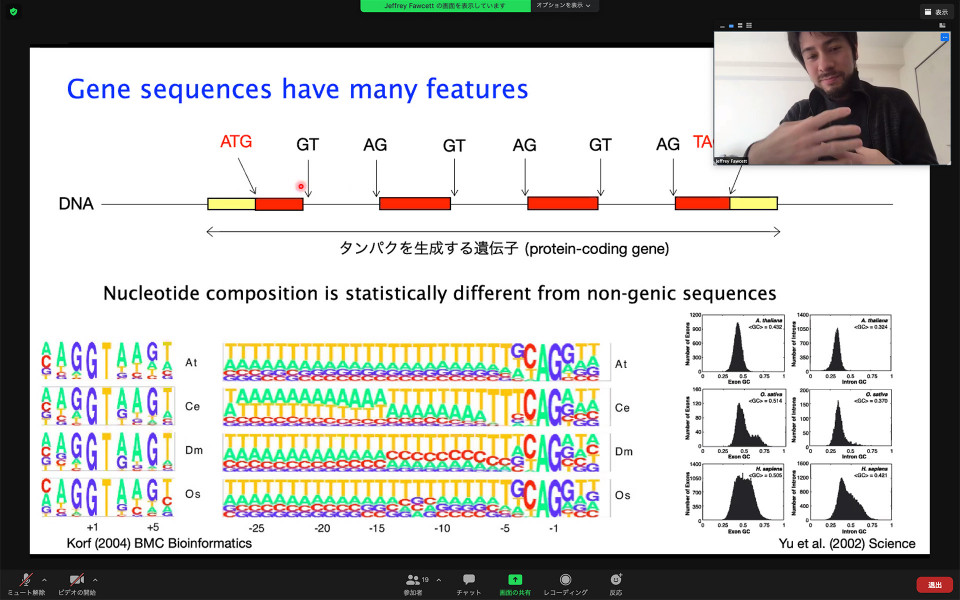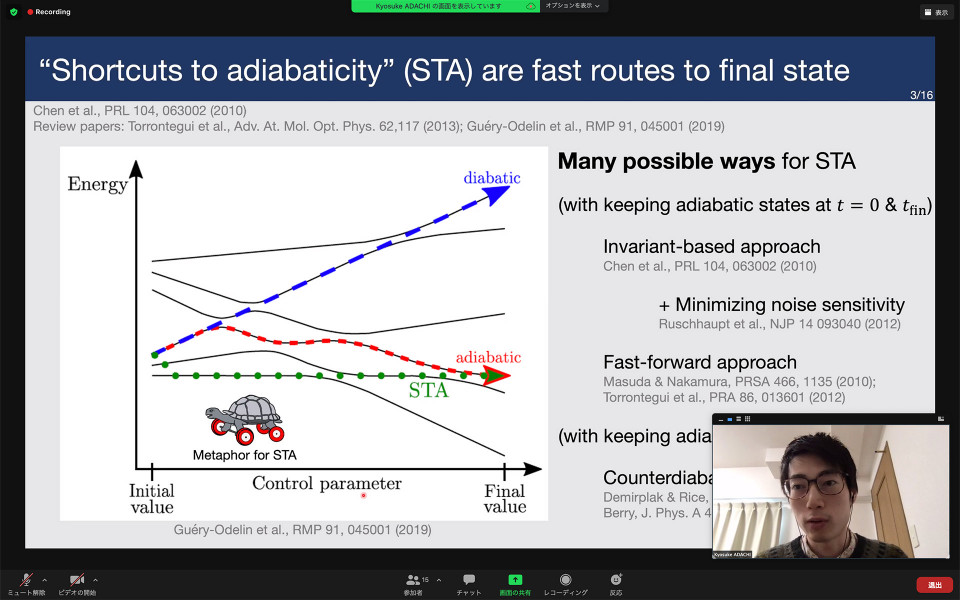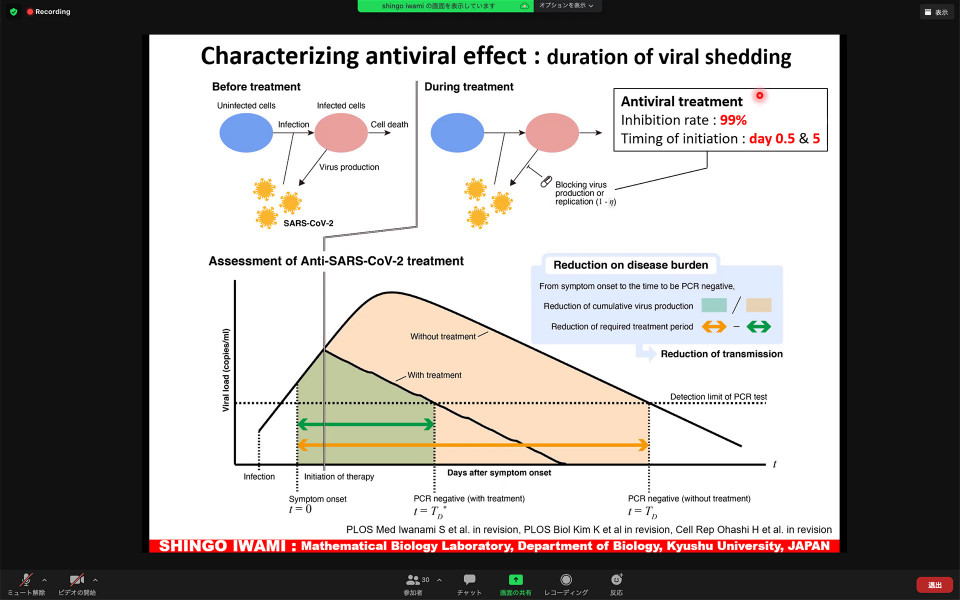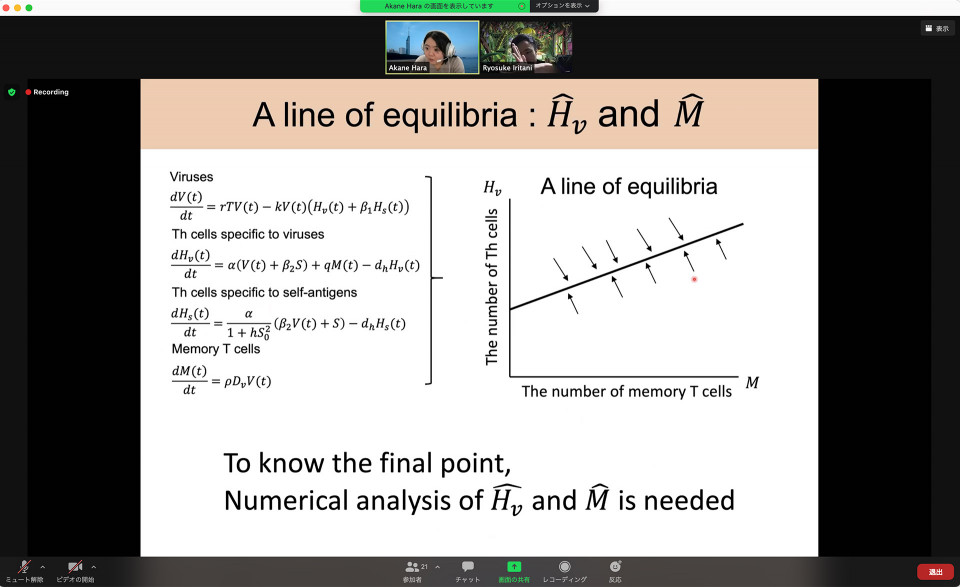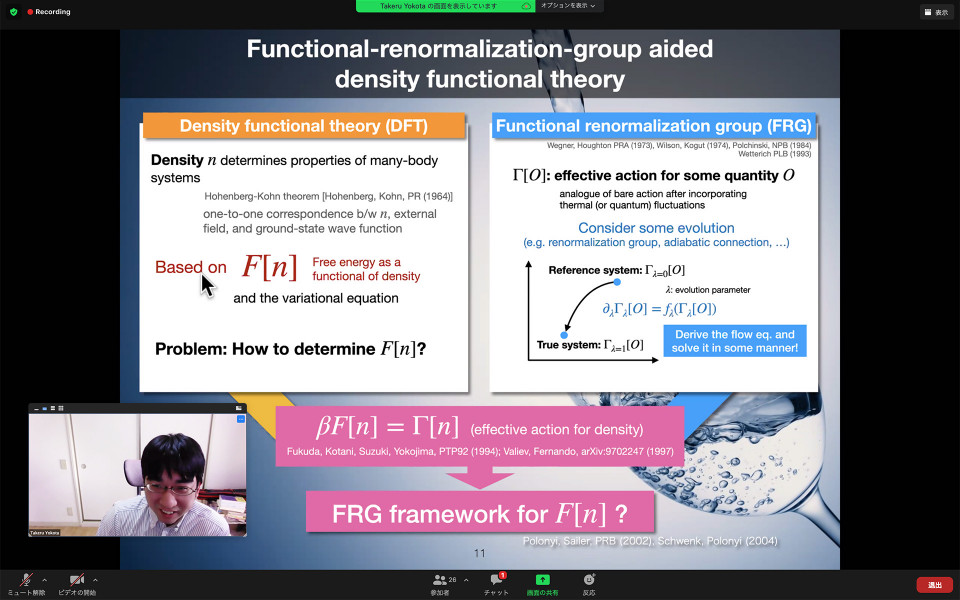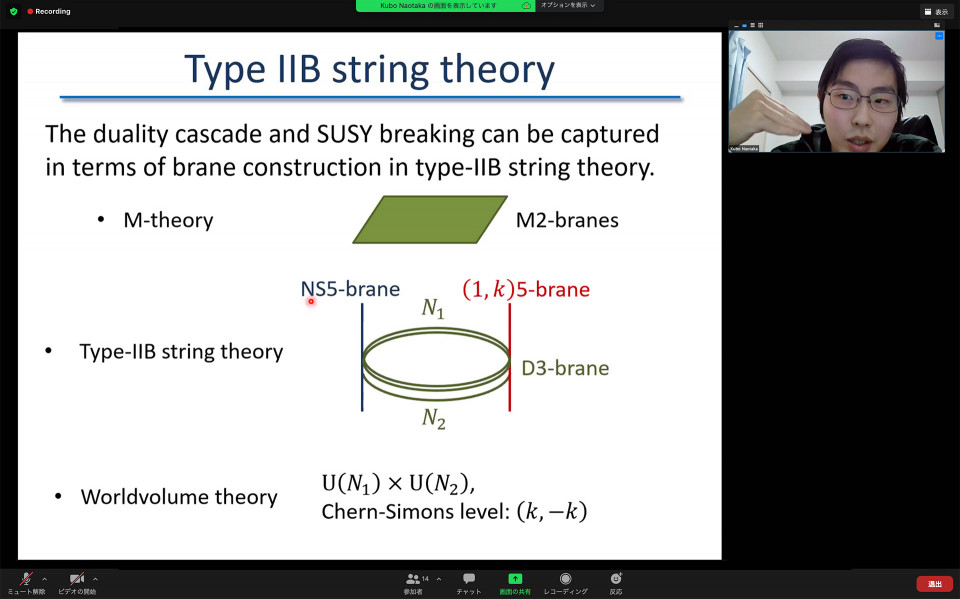Volume 133
Back to Newsletter List
Hot Topic
"Do you really know what the black hole is?" was held on December 6, 2020
2020-12-11
The academist event "Do you really know what the black hole is?" was held on December 6 via YouTube, and iTHEMS members Shigehiro Nagataki (Deputy Program Director), Yoshiyuki Inoue (Senior Visiting Scientist), and Yuki Yokokura (Senior Research Scientist) gave an easy-to-understand explanation of how black holes are born, how to search for black holes, and the inner workings of black holes, mentioning the achievements of the 2020 Nobel Prize in Physics. Please check out the video from related links below.
Presented by iTHEMS & academist - Do you really know what the black hole is?
December 6 (Sun) 14:00 - 16:00, 2020
Research News
RIKEN NEWS: Guerrilla Rainstorm forecast updated every 30 seconds
2021-01-13
It has been a long time since guerrilla rains have become a social problem, threatening our daily lives with localized and sudden fierce rains that cause flooding and power outages. However, current weather forecasting technology is unable to predict the occurrence of guerrilla rainstorms. Team leader Tatemasa Miyoshi (TL) of the Data Assimilation Research Team at the RIKEN Center for Computational Science (R-CCS) has developed an innovative weather forecasting method that takes in and updates observation data every 30 seconds, and is trying to realize guerrilla rainfall forecasting.
Seminar Report
Biology Seminar by Dr. Jeffrey Fawcett on January 14, 2021
2021-01-14
In iTHEMS biology seminar on January 14, Jeffery Fawcett (RIKEN iTHEMS) gave us a talk on what genes are and how we can identify them. He started from the basics such as chromosomes, genes, and how proteins are produced from them. He then explained difficulties in defining a gene. This sounds very interesting because most of us (at least, I) naively think that we know what a gene is, even without knowing a precise definition of it. He also explained how we can predict the location of genes on the chromosomes. Jeff nicely presented keys ideas for non-experts, and all of us enjoyed his talk. I am also working on evolutionary biology, but I have never thought seriously about how genes are identified, and his talk became a nice introduction to this fascinating topic.
Thank you very much, Jeff!
- Takashi Okada
What are genes and how can we find them?
January 14 (Thu) 10:00 - 11:00, 2021
Seminar Report
Information Theory SG by Dr. Kyosuke Adachi on January 13, 2021
2021-01-14
On January 13, Dr. Kyosuke Adachi gave a talk entitled “Accelerated equilibration in classical stochastic systems” at the journal club of information theory study group.
First, he reviewed the concept of shortcuts to adiabaticity (STA) and discussed a two-level system as a concrete example. Then it was explained that STA are fast routes to the final states in quantum systems. Second, he introduced the engineered swift equilibration (ESE) in classical stochastic systems, which is a classical counterpart of STA. Indeed, he explained that the Fokker-Plank equation has a similar structure to the Schroedinger equation, and the fast routes from the initial equilibrium state to the final equilibrium state are ESE. As examples of ESE, compression of Brownian particles, and evolutionary systems were given. Finally, he mentioned some interesting questions. The talk had many stimulating discussions. We are grateful to Adachi-san for his excellent talk!
Accelerated equilibration in classical stochastic systems
January 13 (Wed) 13:00 - 14:00, 2021
Seminar Report
Information Theory SG by Dr. Yukimi Goto on December 23, 2020
2020-12-24
This week, Dr. Yukimi Goto gave us an introduction to the Lieb-Robinson bound. After reviewing several important preliminaries, such as Liouvillians for open quantum systems, she discussed the Lieb-Robinson bound, which is a theorem for the bound on speed of information propagation. She then explained two notable applications of the bound, i.e., correlation decay and the entanglement area law for a gapped ground state in isolated quantum systems. We thank Goto-san for her great talk!
Review on the Lieb-Robinson bound
December 23 (Wed) 13:00 - 14:00, 2020
Seminar Report
Biology Seminar by Dr. Shingo Iwami on December 22, 2020
2020-12-23
In his seminar Dr. Iwami (Kyushu University) presented his mathematical model for coronavirus (新型コロナウイルス) in patients. The aim of the project was to determine why some papers disagreed on the efficacy of certain antiviral drugs to treat the coronavirus. Because the available data was limited, only a simple mathematical model was considered. The mathematical model only represents the fraction of cells remaining to be infected and the amount of virus. The curve for the virus in the model was fitted to the data of virus in the nasal swab of patients. From this analysis, Dr. Iwami's group could separate the patients into 3 types: with either slow, medium or fast decay of virus. He showed that in his model, only early treatment can be effective for all decay types. This can be one reason why two different clinical trials can find different results: if one trial includes late treatment then it can appear that the treatment is not effective. From the mathematical model, he suggested some changes in the criteria for patient inclusion into clinical trials to improve the ability to detect statistically significant effects for the antiviral drug. The seminar was very well attended, with many questions and discussions. Thank you Dr. Iwami for your great talk!
- Catherine Beauchemin (iTHEMS)
Mathematical model-based quantitative data analysis for COVID-19
December 22 (Tue) 10:00 - 11:00, 2020
Seminar Report
Biology Seminar by Akane Hara on December 17, 2020
2020-12-18
In today's biology seminar, we invited Akane Hara, a PhD student at Kyushu University, to have her talk about how pathogen infection can cause autoimmune diseases.
Normally, the immune systems attack germs like viruses and bacteria to prevent their growth within the body. However, these germs may mimic themselves to our body system so that they can avoid the attack. As a result, the immune system is not able to tell the germs from our body parts, and so even after the removal of the germs, it harms our body mistakenly. Wondering why - or when - this is the case, she considered ordinary differential equations of the compartment models for virus, helper cells, and memory T cells, by explicitly considering cross immunity. She presented a mathematical condition for which autoimmune diseases may be present and/or severe. We discussed possible extensions of the mathematical models. Thank you so much for the great talk, Akane! Personally, I was a colleague with her at Kyushu University and so feel a bit emotional that she's completing her PhD very soon!
-Ryosuke Iritani
Autoimmune diseases initiated by pathogen infection: mathematical modeling
December 17 (Thu) 10:00 - 11:00, 2020
Seminar Report
iTHEMS-phys seminar by Takeru Yokota on December 17, 2020
2020-12-18
On December 17, the iTHEMS-phys seminar entitled "Classical liquids and functional renormalization group" given by Dr. Takeru Yokota (ISSP, U. Tokyo) was held. He has been working for the functional-renormalization-group-aided density functional theory (FRG-DFT) for several years. Recently, he is applying this method to classical liquid. As a benchmark calculation, he applied to a one-dimensional exactly solvable system. The exact solution was sucessfully reproduced by the method.
The seminar was held via the Zoom online conference systems. More than 20 people, including outside from iTHEMS, attended the seminar. The discussion was quite lively, and it was continued several hours even after the seminar.
Classical liquids and functional renormalization group
December 17 (Thu) 13:00 - 14:30, 2020
Seminar Report
Math-Phys Joint Seminar by Dr. Naotaka Kubo on December 14, 2020
2020-12-18
His talk was on the test of non-perturbative dynamics of three-dimensional gauge theories from the perspective of brane dynamics in string theory.
In the first half of his talk, he explained important ideas in quantum field theory at an elementary level, such as renormalization group (RG) flow, supersymmetry (SUSY), and world-volume theory on branes in string/M-theory. Combining these fundamental ideas, he moved on to the discussion of duality cascades in quantum gauge theories in four and three dimensions. Using branes in string theory, he demonstrated that the duality cascades in M2-brane world-volume theories can be understood from the brane dynamics in type IIB string theory, which is the so-called Hanany-Witten move/transition. In particular, he mentioned that after the sequence of the Hanany-Witten transitions, one may predict if the original gauge theories have SUSY breaking under the RG flow. Then he concluded that all the world-volume theories related by the Hanany-Witten transitions would flow to the same IR theory, and SUSY will be broken if anti-D3-branes are created.
In the latter part of the talk, he argued the non-perturbative tests of duality cascades in three-dimensional supersymmetric gauge theories using partition functions of the theories. He first introduced the notion of partition functions of quantum field theories on S^3 and rephrased the conclusion given in the first part in the language of partition function. He then illustrated the general idea to exactly compute the partition function of supersymmetric gauge theories, which is an analogue of Duistermaat-Heckman formula and is called supersymmetric localization. He gave a dictionary between the viewpoint of brane configuration and the partition function of supersymmetric gauge theories. With such a dictionary, the Hanany-Witten transition of branes was rewritten by an equality between the partition functions. Moreover, one can directly check the duality cascades and SUSY breaking by calculating the partition functions. Finally, he showed the duality cascades and SUSY breaking in supersymmetric gauge theories by an explicit evaluation of partition functions, with comments on Fermi gas formalism and residue computation.
Non-perturbative tests of duality cascades in three dimensional supersymmetric gauge theories
December 14 (Mon) 16:00 - 18:10, 2020
Upcoming Events
Seminar
Quantum Matter Seminar
Time-dependent driven quantum critical systems in (1+1) dimension
January 18 (Mon) 10:00 - 11:15, 2021
Xueda Wen (Postdocs, Physics Department, Harvard University, USA)
10:00am ~ 11:15am on Jan. 18th, 2021 (JST)
8:00pm ~ 9:15pm on Jan. 17th, 2021 (EST)
I will introduce an analytically solvable setup for time-dependent driven quantum critical systems in (1+1)D, whose low-energy physics are described by conformal field theories. In general, one may observe two different phases (heating and non-heating), where the correlation functions such as the entanglement entropy and energy-momentum density can be analytically solved. The dependence of phase diagrams on (i) the types of driving Hamiltonians and (ii) the types of driving sequences (such as periodic, quasi-periodic and random drivings) will be discussed.
Venue: via Zoom
Event Official Language: English
Seminar
Information Theory Seminar
Information theory in ecology: Markov chain, Venn diagram, Kronecker (and Cartesian graph) products, and Tsallis entropy
January 20 (Wed) 13:00 - 14:00, 2021
Ryosuke Iritani (Research Scientist, RIKEN Interdisciplinary Theoretical and Mathematical Sciences Program (iTHEMS))
This is more like an introductory talk on how I was motivated to work with information theory, and include unpublished data.
Ecologists have been long interested in understanding diversity (divergence) of natural ecosystems. One possible way of accounting for diversity is to use a species' presence/absence table across spatial locations (species-location table), in which we record 1 if a focal species is present in a given site (otherwise 0). Recent interest lies in assessing how diversity (e.g., the number of species) changes with time: for instance, extinction and colonization of species may result in the modification of such tables with time. However, we are yet to have theoretical toolkits to model the dynamics of spcies-site tables. In this talk, I will introduce my model (in collaboration with R. Hamazaki, S. Tatsumi, and M Cadotte) of the dynamics of species-site tables based on Markovian stochastic processes. Specifically, our apporach allows us to analytically obtain the solution of the full stochastic dynamics by means of localizing the dynamics to a single site and then expanding it towards the global sites with Kronecker's prodcut (in linear algebra) or Cartesian product (in graph theory). Intuition obtains from illustrating the dynamics onto Venn diagram, where we draw several sets (corresponding to locations) and binary numbers (corresponding to presence-absence data) and consider random walks on Venn diagram acorss sets; also this Venn diagram based interpretation is mathematically underpinned by Cartesian product of graphs. Finally I will briefly talk about how we assess diversity of ecosystems using Tsallis entropy (or the generalized Shannon entropy).
Venue: via Zoom
Event Official Language: English
Seminar
iTHEMS Theoretical Physics Seminar
Many body problems from quarks to stellar evolutions
January 28 (Thu) 13:30 - 15:00, 2021
Nobutoshi Yasutake (Associate Professor, Chiba Institute of Technology)
The many-body problems are major problems that need to be clarified not only in nuclear physics, but also in astronomy. In this seminar, I introduce stellar evolutions as gravitational many-body problems, and also hadronic matter as quantum many-body problems, based on the Lagrangian schemes. The macroscopic stars and the microscopic hadronic matter look completely different issues. But in this seminar, I introduce the similarities between the two problems. For hadronic matter, we adopt the color molecular dynamics to understand the behaviors and properties of hadronic matter in the framework of QCD. Although molecular dynamics can not be the first-principle, they are sometimes useful to understand many-body quantum properties. In this talk, we introduce the current status of our color molecular dynamics.
Venue: via Zoom
Event Official Language: English
Workshop
Co-hosted by iTHEMS
The 12th RIKEN-Kyoto University Joint Data Assimilation Workshop
February 10 (Wed) 13:30 - 16:30, 2021
Language: Japanese/English
Participation deadline: Tuesday, February 9, 2021
Venue: via Online
Event Official Language: Japanese
Paper of the Week
Week 3 of January
2021-01-14
Title: A note on exotic families of 4-manifolds
Author: Tsuyoshi Kato, Hokuto Konno, Nobuhiro Nakamura
arXiv: http://arxiv.org/abs/2101.00367v1
Title: Local Operator Entanglement in Spin Chains
Author: Eric Mascot, Masahiro Nozaki, Masaki Tezuka
arXiv: http://arxiv.org/abs/2012.14609v1
Title: Chiral separation effect catalyzed by heavy impurities
Author: Daiki Suenaga, Yasufumi Araki, Kei Suzuki, Shigehiro Yasui
arXiv: http://arxiv.org/abs/2012.15173v1
Title: Tensor-force effects on shell-structure evolution in N = 82 isotones and Z = 50 isotopes in the relativistic Hartree-Fock theory
Author: Zhiheng Wang, Tomoya Naito, Haozhao Liang
arXiv: http://arxiv.org/abs/2012.13143v1
Title: Second order chiral kinetic theory under gravity and antiparallel charge-energy flow
Author: Tomoya Hayata, Yoshimasa Hidaka, Kazuya Mameda
arXiv: http://arxiv.org/abs/2012.12494v1
Title: Exceptional Dynamical Phase Transitions in Periodically Driven Quantum Systems
Author: Ryusuke Hamazaki
arXiv: http://arxiv.org/abs/2012.11822v1
Title: Fermion doubling theorems in 2D non-Hermitian systems for Fermi points and exceptional points
Author: Zhesen Yang, A. P. Schnyder, Jiangping Hu, Ching-Kai Chiu
arXiv: http://arxiv.org/abs/1912.02788v3
If you would like to cancel your subscription or change your email address,
please let us know via our contact form.
Copyright © iTHEMS, RIKEN. All rights reserved.


